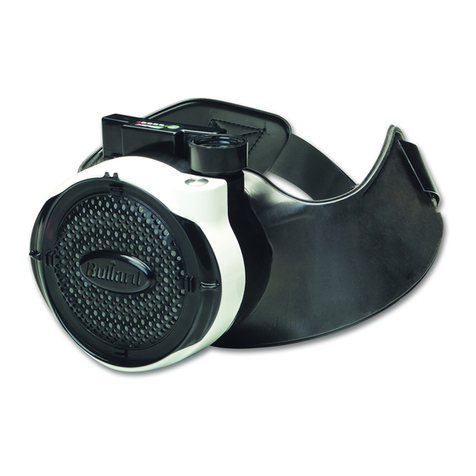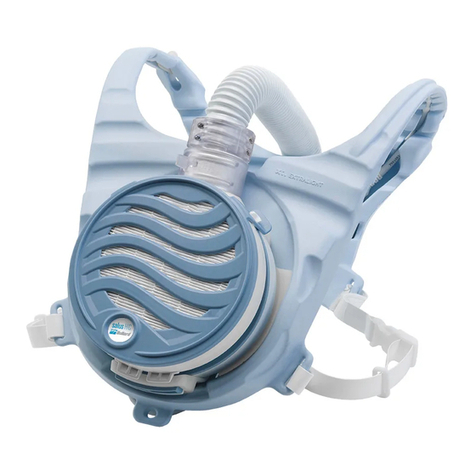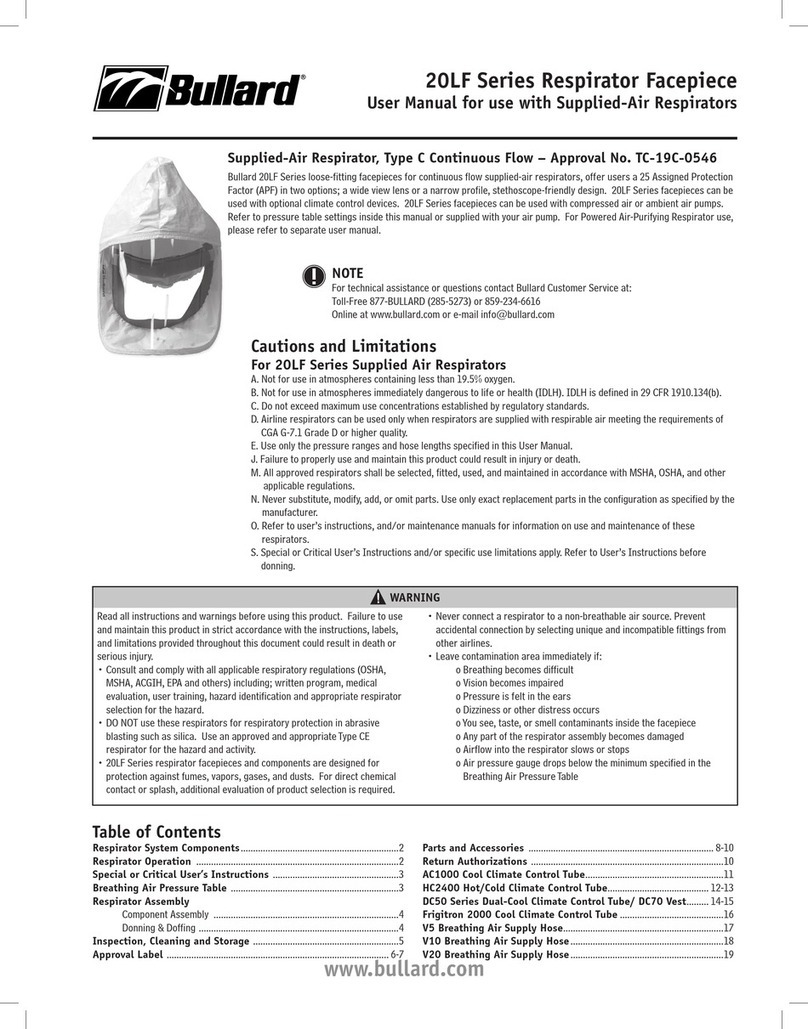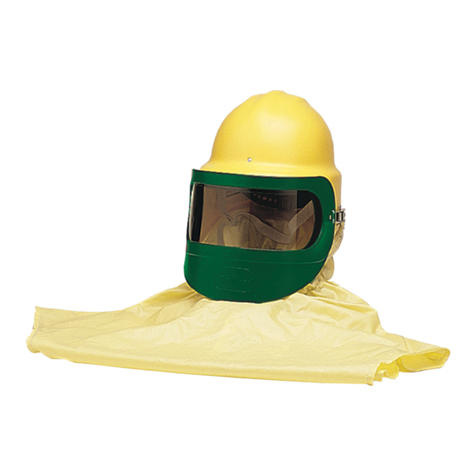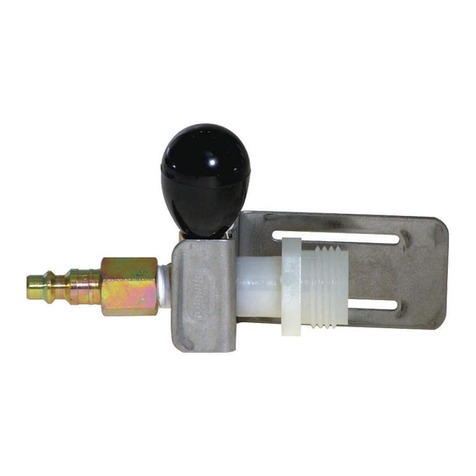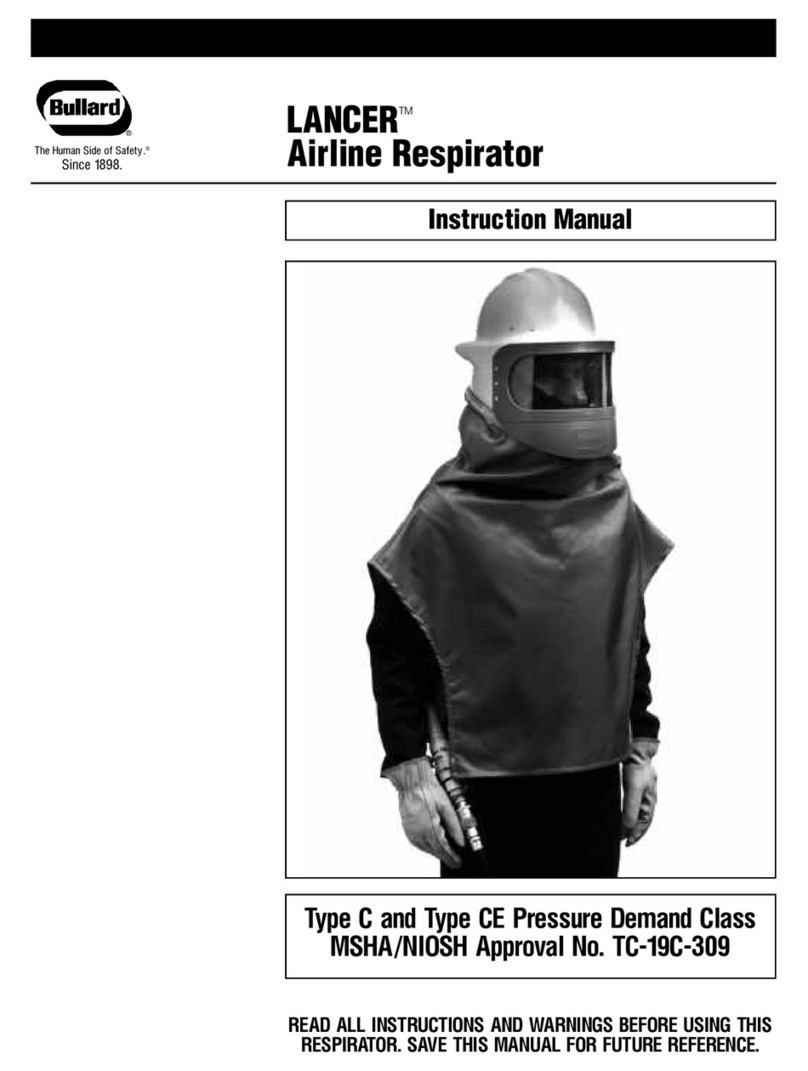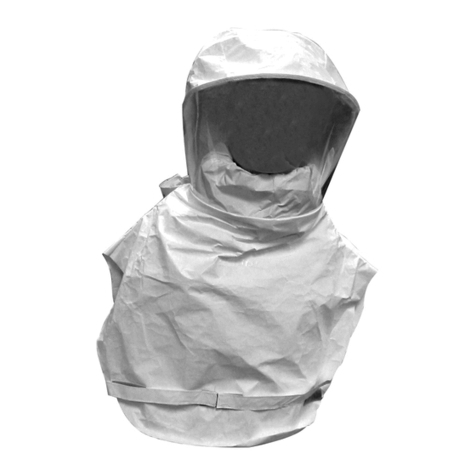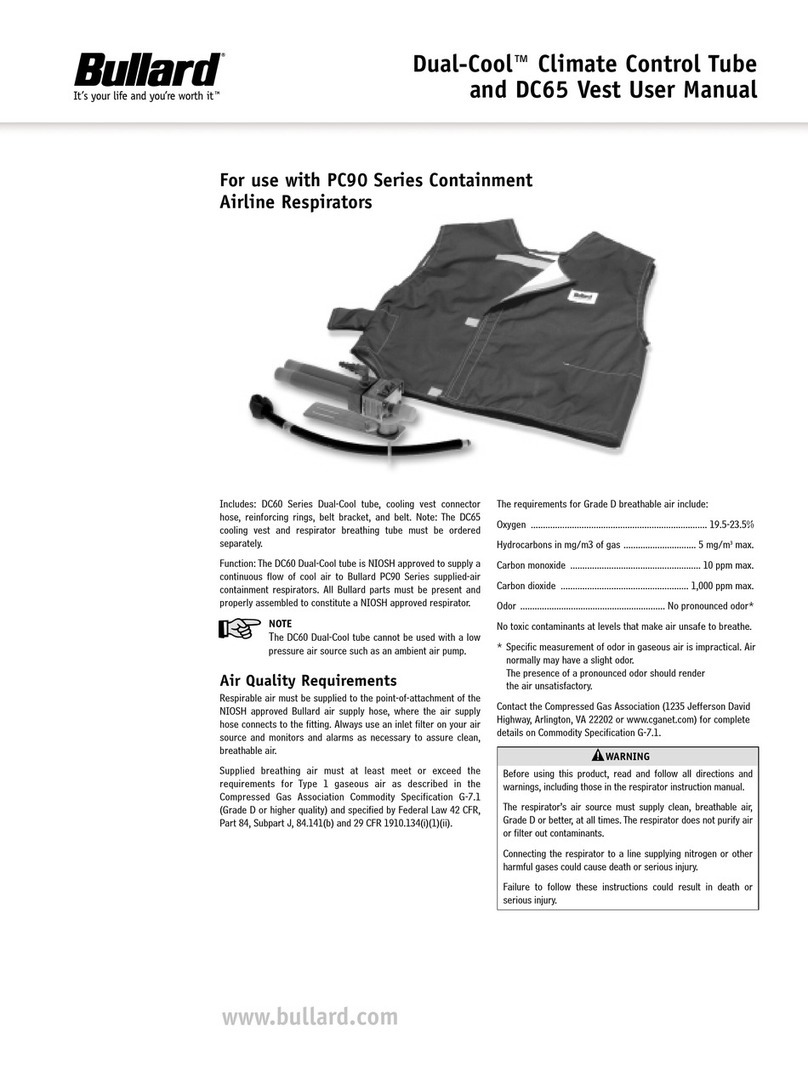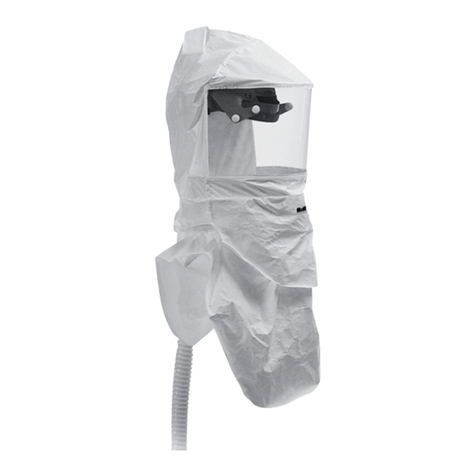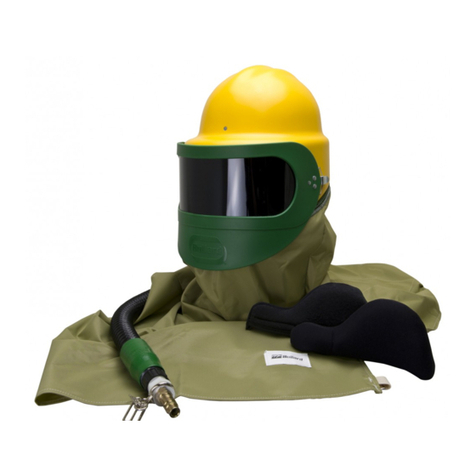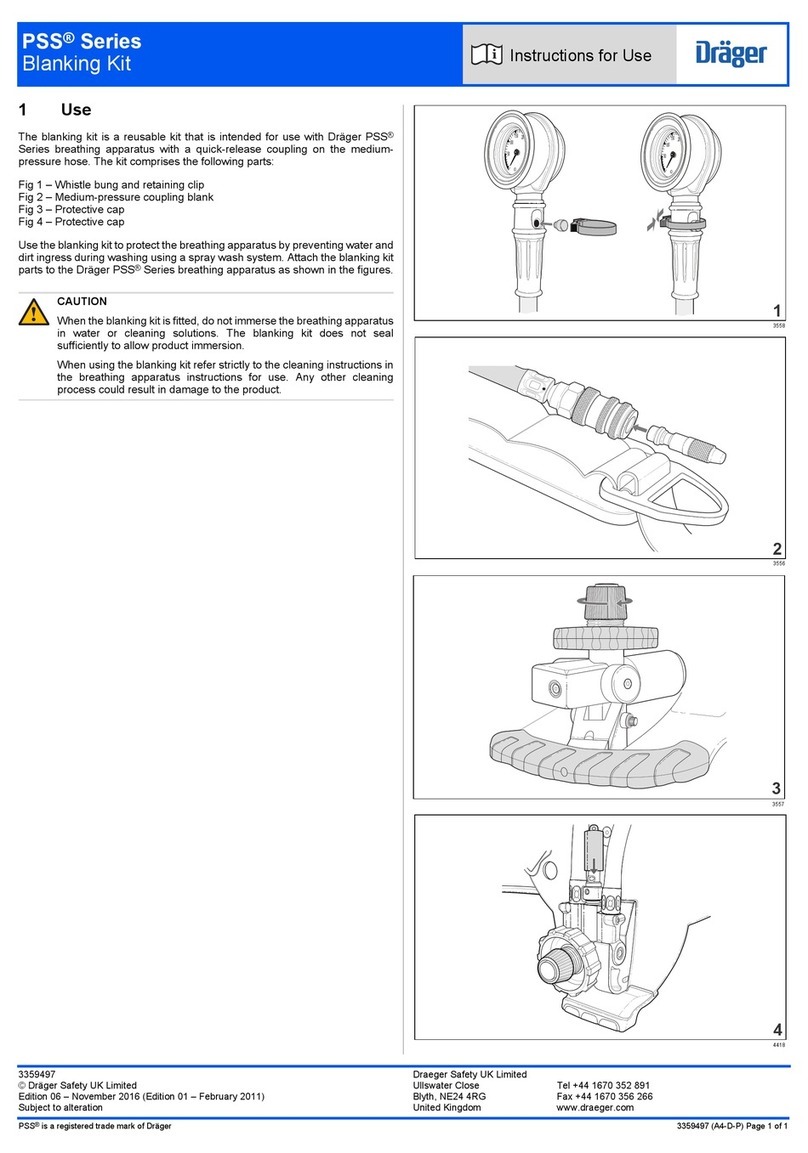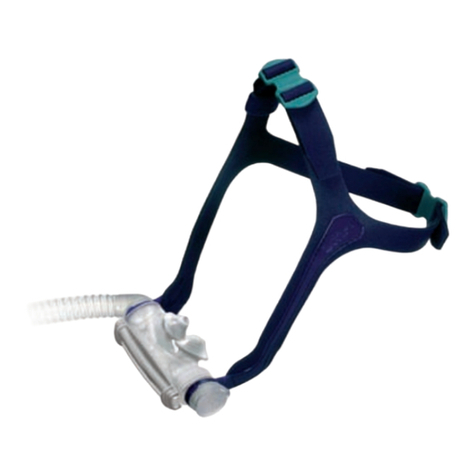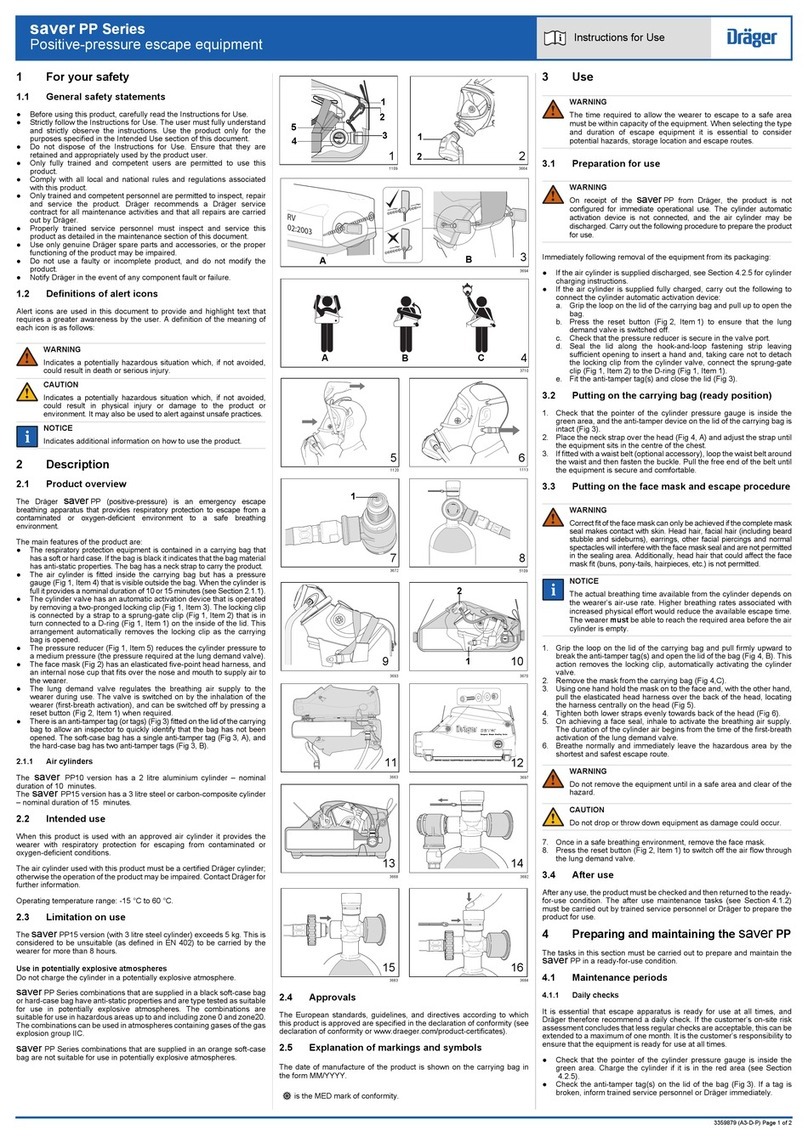
www.bullard.com
2
Principle of Operation / Battery Pack
PA3IS - Principle of Operation
The PA30IS Powered Air-Purifying Respirator (PAPR) System is supplied in six parts:
1.The blower assembly (Part No. PA3IS) which includes:
PA3ISBU Blower Unit
PA1SB Belt or PA1DB Decon Belt
PA1AFI Air Flow Indicator
2. The battery pack, Part No. PA3ISBP, will last approximately seven hours.
3. The breathing tube, which is available in two different types:
PAHBT Powered Air Hood BreathingTube Assembly (standard length)
PAHBTXS Powered Air Hood BreathingTube Assembly (short length)
PAHBTXL Powered Air Hood BreathingTube Assembly (long length)
PA1BT Hood breathing tube assembly with clamp (standard length)
PA1BTXS Hood breathing tube assembly with clamp (short length)
PA1BTXL Hood breathing tube assembly with clamp (long length)
PA20LFBT Loose fitting facepiece breathing tube assembly (standard length)
PA20LFBTXS Loose fitting facepiece breathing tube assembly (short length)
PA20LFBTXL Loose fitting facepiece breathing tube assembly (long length)
4. The cartridges are available in different types for most toxic contaminants. (See pages
4 and 7 for a listing of the cartridges.) The types include High Efficiency particulate only,
chemical cartridges for gases and vapors, and combination cartridges for gases, vapors
and particulates.
5. The hood with headband suspension and/or hard hat, or loose fitting facepiece.The
following hood models may be used with the PA3ISBU blower unit:
RT1/RT1T Hood with long inner and outer bib (NIOSH approved for use without a
headband suspension)
RT2/RT2T Hood with long inner and outer bib (NIOSH approved for use without a
headband suspension)
RT3/RT3T Hood with long inner and outer bib (NIOSH approved for use without a
headband suspension)
RT4/RT4T Hood with long inner and outer bib (NIOSH approved for use without a
headband suspension)
20TJ/20TJT Hood
20TIC/20TICT Hood with inner bib
20TICH/20TICHT Hood for use with Bullard hard hat
20TICS/20TICST Hood with taped and sealed seams
20SIC/20SICT Hood with taped and sealed seams
20SICV/20SICVTHoodwithtapedandsealedseamsandPVClens
20SICH/20SICHT Hood with taped and sealed seams for use with Bullard hard hat
20SICVH/20SICVHTHoodwithtapedandsealedseamsandPVClensforusewith
Bullard hard hat
20LFM Loose fitting facepiece, medium size
20LFL Loose fitting facepiece, large size
20LFXL Loose fitting facepiece, extra large size
20LF2M Loose fitting facepiece (narrow profile), medium size
20LF2L Loose fitting facepiece (narrow profile), large size
20LF2S Loose fitting facepiece (narrow profile), small size
6. The Battery Charger:
PA3ISC Quick Charger (single port)
PA3ISGC Gang Charger (six port)
The blower unit draws in ambient air through the cartridges.The purified air is blown into
the wearer’s hood through the breathing tube. A flow indicator is provided to check that
there is an adequate volume of air available to the wearer prior to use.
The units are designed for use at temperatures from 10ºF to 120ºF (-12ºC to 49ºC).The
system is designed to operate at a minimum air flow of approximately seven cubic feet of air
per minute (198 liters per minute) in the hood under normal use.
The battery pack(s) mount in compartment(s) on the back of the blower. One fully charged
battery pack will power the blower for approximately seven hours.
The PA3ISBU is fitted with an alarm which will sound when voltage is low.
CC20 and RT Series Airline Respirator
NIOSH Approval No. TC-19C-154, Type C and TC-19C-412, Type C
Most of the same headpieces approved for use with the CC20 and RT Series of supplied air
respirators (SARS) are also approved for use with the PA30 Series of powered air-purifying
respirators. CC20 and RT Series respirators provide a high level of respiratory protection
and user comfort over long work periods, in a wide variety of hazardous environments.
The CC20 and RT SAR air flow control devices and other components are described in the
CC20 and RT Series User Instructions.
Battery Pack
A fully charged battery pack will power a blower unit to provide adequate air volume for the
respirator for approximately seven hours for the PA3ISBU.
To charge the battery pack, do the following:
•Openthebatterylatchandremovethebatteryfromthebackoftheblower.
WARNING
Make sure that the Blower Unit has been shut off completely before removing the
battery. DO NOT remove the battery while the unit is running. DO NOT install a
battery into a blower that has been left in the “on” position. Failure to follow these
instructions may cause damage to the battery and may put the wearer at risk.
•Placeeachbatteryinthechargingportsofthebatterycharger.Ensurethatthebattery
contacts line up with the contacts in the charger port (see Figure 1).
•Connectthebatterychargertoa115-voltACelectricaloutlet.
Charge the battery pack for approximately eight hours.
While the PA3ISBP battery is charging, the light on the cord will
remain red. When the unit is charged, it will turn green.
Table-top gang chargers (Part No. PA3ISGC, with 6 ports)
and analyzers/conditioners are also available.
To maximize battery life, these guidelines should be
followed:
•Chargethebatterypackbeforeitiscompletelydischarged.Thelow
voltage alarm indicates that the battery needs to be charged.; operating
the PAPR for more than 20 minutes after the alarm has been activated may damage the
battery. Deeply discharged batteries may cause the charger to falsely indicate a complete
charge.
•Alwayschargethebatteriesatroomtemperatureorless.Athighertemperatures,the
battery pack may not accept a full charge. If the battery pack feels hot, let it cool for 30
minutes before charging.
•Donotchargebatterypacksinanenclosedcabinetwithoutventilation.
•Batterycapacitymaybecheckedwithbatteryanalyzer/conditioner.
Table-top gang chargers (Part No. PA3ISGC, with 6 ports) are also available.
WARNING
PA3BP battery packs MUST be used with PA3 blower units and PA3ISBP intrinsi-
cally safe battery packs MUST be used with PA3IS blower units. Interchanging
these batteries with blowers may cause damage to the blower and battery AND
the blowers will not operate as intended and may put the wearer at risk. Failure to
follow these instructions may result in death or serious injury.
Figure 1
